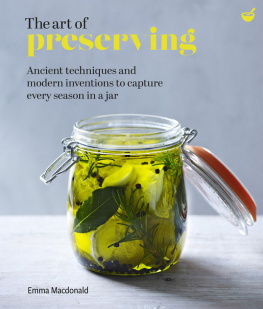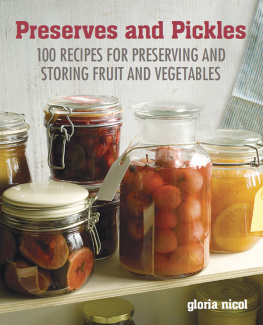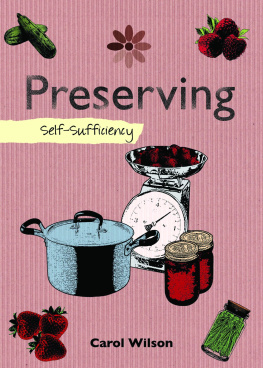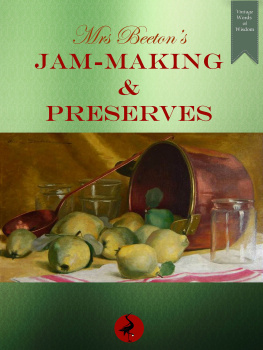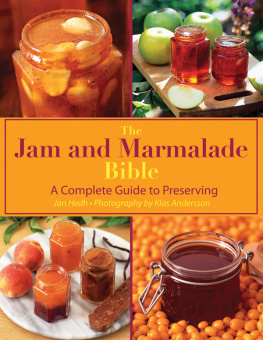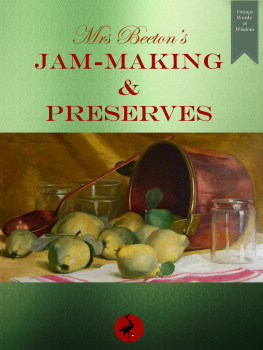Contents About the Book First published in 1970, Beryl Woods classic Lets Preserve It is the ultimate preserving bible. In this small encyclopaedia, Wood distils the immense knowledge of earlier generations into a jarful of simple, foolproof recipes that will give endless delight both to make and to savour. With guidelines on equipment and preparation, useful hints on cooking and important tips to remember, this A-Z of recipes is an essential book for everyone from the experienced jam-maker to new cooks making preserves for the first time. Classic recipes such as mint jelly, lemon curd and Seville orange marmalade are all here, as well as more unusual combinations and ideas for preserving fruits, herbs and vegetables. This unique and comprehensive recipe book revives the art of making jams, jellies, pickles and chutneys, and celebrates the joys of transforming a surfeit of anything from apples to whortleberries into jars full of sweetness.


Foreword When I first turned the pages of Beryl Woods remarkable book, I was as struck by its astonishing range as I was by its history.
Foreword When I first turned the pages of Beryl Woods remarkable book, I was as struck by its astonishing range as I was by its history.
Published in 1970, a time when the trend for cheap convenience food was well into its stride and state of the art technology was widely acknowledged as the way forward as the means to feed a growing population, Woods collection of preserving recipes was a manifesto for safeguarding our grandmothers artisan ways. Her book was a nudge that reminded not to walk past a hedgerow without collecting a few rosehips or blackberries during their season, nor miss a glut of cheaply abundant fruits or vegetables. She reminds us that making just a few pots of pickles, jam, jelly or fruit curd upholds a great and endangered tradition. She called the experience of opening a cupboard stocked with your own homemade preserves worthwhile, but she was not just talking about the economic benefit but of lifes deep rooted, hand-me-down qualities to be lost at our peril. Her own upbringing and unconventional life explains her interest in traditional cooking. Beryl Wood grew up in Kent, the garden of England where she remembered picking fruit for preserving at an early age.
As an adult she was secretary to a progressive obstetrician in South Africa, Dr Grantly Dick-Read. When he and his family moved to Britain, she returned with them and added the care of their vegetable garden to her duties . Her off-beat career extended to a stint at pest control, working in a restaurant and also running an all-women car hire firm. Having decided to embark upon a book of preserves, she could not have taken a more exemplary route, combing libraries and bookshops for authentic recipes, but best of all prising grandmothers recipes from families. All is arranged in what is to my mind the easiest, most accessible recipe book format an alphabetical listing by ingredient. When the season for each fruit, vegetable or nut arrives, it takes just a few seconds to look up at least one way to preserve it, and there is helpful cross-referencing to other sections in the book.
There are nearly 600 recipes, from apple butter to wine jelly and finally Woods XYZ end of season relish, a recipe that polishes off the unripened green tomatoes and last of the peppers no-one is ever sure what to do with. So much of the appeal lies in the brevity of the recipes. Anyone who can bring the contents of a pan to the boil and simmer it gently can follow this book. But above all this is a perfectly judged collection that contains the classics raspberry jam, lemon curd and marrow chutney, for example but also many intriguing curiosities. Red berries and orchard fruits are added through the summer season to a brandy-filled earthenware pot for Fruit Cockayne, ready to eat at Christmas; there is a sauce made from the peppery flavoured flowers of a nasturtium; a jam made from cucumbers and another from coconut and over forty ways to pot, pickle or preserve a wind-fallen apple. You can only imagine and fantasise about the history of these recipes; picture the eighteenth-century cook who dreamt up the idea of combining marrows with blackberries in a chutney, stirring the pot over a small flame, waiting for the contents to thicken enough to be ready for potting.
We cooks are more than ready for Beryl Woods wonderful work again. The emergence of farmers markets selling gluts of British vegetables, and the rediscovery of the fun in foraging and an interest in global flavours, has brought eclecticism back to cooking. Inspiration drawn from the creativity of chefs, both from eating out and watching their television spectacles, shows how a little herb-flavoured fruit jelly can transform the ordinary dish to the extraordinary. Concern for the economic climate, environment and health has further renewed and underpinned that interest. There is new relevance to a book of preserves that fits perfectly in our time. With Beryl Woods unmatchable work, her encouraging voice and inspirational recipes, the words bland and British can never be linked again.
Rose Prince, London 2011 Introduction Cooking today is totally different from that of our great-grandmothers, or even grandmothers, both in quantity and style, but we should not allow ourselves to lose many of their flavoursome and economical adjuncts to the family meals. The trend has been for quick foods accompanied by a glass jar or tin from the shelf of the supermarket round the corner, but it is satisfying to find a way of life that does not always revolve round the flick of the television switch or its equivalent. Home-baking has been making a big comeback, and the comfort of an open fire (even with smokeless fuel) with the delight of buttered fresh bread and muffins on a Sunday afternoon are once more being appreciated. It seemed to me, however, that Grannys famous store-cupboard had been badly neglected. Perhaps it was the thought of 23kg (50lb) of marmalade or 11kg (25lb) of strawberry jam at one go, and few houses today have the space for such quantities, nor has the working wife time to handle them. But there is no need to make more than small manageable amounts with the days chores (or as a change from painting a room at the weekend).
The pleasure to be gained from opening a cupboard of your own homemade chutneys and jams, particularly of unusual varieties, is a very worthwhile experience. My large library of cookery books yielded me only one or two recipes for preserves to every hundred or two others, so I set myself the task of collecting and annotating such recipes from all possible sources. Over the months the numbers swelled, the varieties became increasingly interesting and the cooking of them fascinating. And I realized there must be others who would enjoy the pleasure of making and trying out new tastes or variations of a known recipe. A day in the country can provide the basis for good jams, free for the picking from the hedges, a supply of nuts for Christmas and many other useful items of provender, all for the price of a health-giving spell in the open air. Sometimes a cheap and rather despised vegetable like the marrow can yield a most delicious curd for tarts or with toast for tea.
So I put them all together, in some cases three or four different ones for an individual product, and you can take your choice from the flavours you think most enjoyable to your palate and that of your family. As you gain experience, try out combinations of flavours for yourself it is surprising how easy this is once you have mastered the basic principles. In quoting the ingredients, I have listed the smallest practical quantities it is so much easier to double than halve! In some cases, therefore, the recipes are very much trial quantities. Fruits and vegetables are in alphabetical order, cross-referencing as necessary, so if you like plums, prunes or tomatoes you will find them all together, whether a jam, jelly or pickle. Thus, no index. This volume is devoted entirely to preserving that can be done with the basic tools found in every kitchen; you will find no mention of bottling, canning or deep-freezing because each of these methods requires special equipment or facilities.
Next page

